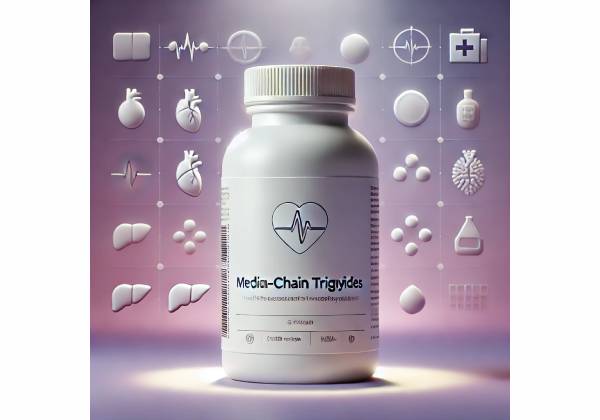
Medium-chain triglycerides (MCTs) are a family of dietary fats—primarily caprylic (C8) and capric (C10) acids—valued for rapid absorption, clean energy, and reliable ketone production. Because MCTs travel straight from the gut to the liver and bypass the usual fat-transport steps, they are oxidized quickly and seldom stored. That pharmacokinetic “shortcut” is why MCT oil shows up in ketogenic diets, clinical nutrition formulas for malabsorption, and some weight-management protocols. People also add small amounts to coffee, smoothies, or medical shakes to boost satiety or mental clarity. The strongest evidence base sits in epilepsy care (ketogenic therapy), with growing but mixed data for weight control and cognition. MCTs are not magic bullets, however. Too much too soon can upset your stomach; and for a subset of medical conditions—particularly inborn errors of fatty-acid oxidation—MCTs can be inappropriate. This guide translates the research into practical steps: how MCTs work, what benefits are realistic, how to dose without GI trouble, and who should avoid them.
Essential Insights
- Supports nutritional ketosis and may aid fat loss when replacing other calories; limited direct exercise benefits.
- Start low and increase slowly to reduce GI upset; typical intake 5–30 mL/day.
- Common daily range: 15–30 mL (1–2 Tbsp), divided with meals.
- Avoid with medium-chain acyl-CoA dehydrogenase (MCAD) deficiency or past pancreatitis unless medically supervised.
Table of Contents
- What are MCTs and how they work
- Real benefits: what to expect
- How to use MCTs day to day
- How much to take and when
- Side effects, interactions, and who should avoid
- What the research says so far
What are MCTs and how they work
Medium-chain triglycerides are fats whose constituent fatty acids are 6–12 carbons long. In supplements and medical formulas, you’ll mostly see C8 (caprylic acid) and C10 (capric acid), sometimes blended; a few products add C12 (lauric acid), which behaves metabolically more like a long-chain fat and produces fewer ketones per gram than C8.
Absorption and transport. Unlike long-chain triglycerides (LCTs), MCTs:
- require little bile and fewer pancreatic lipases for digestion,
- are absorbed directly into the portal vein (not packed into chylomicrons first),
- reach the liver quickly, where they are oxidized to ATP or converted to ketone bodies (beta-hydroxybutyrate, acetoacetate).
Why this matters.
- Faster energy. The liver rapidly turns C8/C10 into ketones that can cross the blood–brain barrier and serve as a clean fuel for neurons and muscle.
- Lower storage propensity. Because they are preferentially oxidized, a smaller fraction is stored in adipose tissue compared with LCTs (still calories, but higher “burn-through”).
- Digestive advantages in malabsorption. MCTs need less bile and fewer enzymes, so they are frequently used when fat absorption is impaired (e.g., certain pancreatic or biliary conditions), as part of clinician-directed nutrition plans.
Ketone yield by chain length. C8 > C10 >> C12 for acute ketone production. That’s why many “cognitive” or “keto coffee” products emphasize C8, while clinical feeds may use blended C8/C10 for GI tolerance and cost.
Calorie value and cooking. MCTs supply roughly 8.3 kcal/g (slightly less than 9 kcal/g for typical fats). They have a low to moderate smoke point (~160 °C / 320 °F) and a neutral flavor; use them in cold or low-heat applications (smoothies, dressings, finishing oil), not for high-heat frying.
Terminology to know.
- MCT oil: purified C8/C10 triglycerides from coconut or palm kernel oil.
- MCT powder: MCT oil sprayed onto a carrier (often acacia fiber); check labels for added carbs or emulsifiers.
- Coconut oil: not the same as MCT oil. It contains some MCTs but is ~40–50% lauric acid (C12) and a mix of longer saturated fats; it does not replicate MCT oil’s ketone response.
Bottom line. MCTs are specialized fats that trade storage potential for speed: quick absorption, quick oxidation, and dependable ketone generation—useful in ketogenic diets and select clinical contexts, with practical benefits for some everyday users.
Real benefits: what to expect
1) Support for ketogenic therapies and ketosis. Because C8/C10 produce ketones efficiently—even when total dietary carbohydrates are not ultra-low—MCTs are core tools in ketogenic dietary therapies. In “MCT ketogenic” plans, a portion of dietary fat comes from MCTs, allowing a bit more protein or carbohydrate flexibility while preserving therapeutic ketone levels. Outside of medical keto, a tablespoon of C8 in the morning can raise circulating ketones modestly for several hours, which some people perceive as steadier mental energy.
2) Weight-management assist (modest, not dramatic). Controlled dietary studies suggest that replacing equal calories of long-chain fats with MCT oil can slightly increase daily energy expenditure and may help reduce body weight and fat mass over weeks to months. Mechanisms include increased fat oxidation, spontaneous reduction in later meal intake for some users, and a mild thermic effect. Expect incremental changes—measured in percentage points—when MCTs are used as a swap, not an add-on. If you pour MCTs on top of an unchanged diet, you will likely gain calories, not lose fat.
3) Cognitive fuel in specific scenarios. MCT-derived ketones provide an alternate brain fuel. In mild cognitive impairment or Alzheimer’s disease, trials using emulsified C8/C10 have reported small, variable cognitive improvements—often more pronounced in individuals without the APOE-ε4 allele. For healthy adults, subjective “mental clarity” after MCTs is common but not guaranteed; objective performance benefits are inconsistent.
4) Clinical nutrition and malabsorption. In conditions with reduced bile flow, pancreatic insufficiency, short bowel, or certain lymphatic transport disorders, MCTs can be better tolerated than long-chain fats. They are frequently incorporated into enteral formulas or medical diets under professional supervision to maintain calorie intake without worsening steatorrhea.
5) Exercise and endurance: temper expectations. Despite marketing, most controlled trials find little to no improvement in endurance performance from acute MCT dosing. Ketones rise, but GI disturbance often does too—especially above ~30 g at once—offsetting any theoretical energy advantage. Where MCTs can fit is as a small component of a training diet for athletes already adapted to using fat and ketones (e.g., strict ketogenic endurance athletes), and even then the benefits are subtle.
What MCTs don’t do.
- They don’t “melt” fat independent of calorie balance.
- They don’t replace sleep, training, micronutrients, or medical therapy.
- They aren’t a cure for neurodegenerative disease.
Takeaway. The most credible use cases are keto support, modest weight-management assistance when replacing other fats, and clinical nutrition for malabsorption. Cognitive and athletic claims exist but are mixed; try cautiously and evaluate your own response.
How to use MCTs day to day
Start low, go slow. GI tolerance varies widely. Begin with 5 mL (1 teaspoon) once daily with food for 3–4 days. If tolerated, add a second 5 mL dose later in the day. Increase by 5 mL increments every few days until you reach your personal ceiling (often 15–30 mL/day, split).
Timing options (choose one or two and be consistent).
- Morning focus: 5–10 mL C8 in coffee or tea with breakfast for a ketone bump without heavy calories.
- Pre-work block: 5–10 mL before a cognitively demanding task; pair with protein and fiber to prevent rapid hunger return.
- Workout companion (advanced users): up to 15 mL 30–60 minutes pre-endurance session if you’re already fat-adapted; otherwise, skip pre-exercise MCTs to avoid cramps or urgent pit stops.
- Clinical use: follow your clinician’s prescription in enteral or specialty formulas; do not self-modify these diets.
What to pair with MCTs.
- Protein and fiber to blunt rapid gastric emptying and enhance satiety.
- Carb strategy depends on goals:
- For deep ketosis: keep net carbs low and use MCTs to widen food choices slightly.
- For general wellness: replace some cooking oils or butter with MCTs without adding net calories.
Form matters.
- C8 (caprylic) oil: maximal ketone response; slightly pricier; can be harsher on the gut if you rush dosage.
- C8/C10 blends: gentler for many; solid starting point.
- Powders: easier on digestion for some; check the ingredients (carrier type, sweeteners, added carbs).
- Coconut oil: culinary fat with some MCTs; not a substitute for purified MCT oil in dosing or ketone effects.
Culinary tips.
- Use MCTs in smoothies, yogurt, oatmeal after cooking, salad dressings, chilled soups.
- Avoid high-heat frying; combine with olive oil or avocado oil if you need cooking stability (add MCT after heat when possible).
Habit-building checklist.
- Define your “why” (keto support, appetite management, clinical plan).
- Choose a form (C8 vs blend) and a starting dose of 5 mL.
- Track tolerance, hunger, energy, and (if relevant) ketone readings for 2 weeks.
- Keep a calorie swap mindset: replace, don’t add.
- Reassess at 4–6 weeks; continue if benefits outweigh GI costs.
Travel and workarounds. Single-serve sachets or MCT powder packets are convenient and less messy. If you’re sensitive, take with a small meal rather than on an empty stomach.
How much to take and when
Everyday wellness or keto support
- Typical daily range: 15–30 mL/day (1–2 tablespoons), divided with meals.
- Ceiling for many: 30–45 mL/day, depending on tolerance and total calories.
- Conversion: 1 Tbsp (15 mL) ≈ 13–14 g MCT oil.
Weight-management contexts
- Use MCTs to replace an equivalent amount of other fats (e.g., olive oil, butter), keeping total calories aligned with your plan.
- Start at 5–10 mL once or twice daily and titrate to 15–30 mL/day if GI comfort allows.
- Combine with 25–35 g/day of fiber, adequate protein, and resistance training for best results.
Cognitive applications
- For an acute ketone rise, 10–15 mL C8 with breakfast or mid-morning is common.
- If you track blood ketones, evaluate your own dose–response curve; many see a 0.3–0.8 mmol/L bump within 1–2 hours.
Endurance training
- If experimenting pre-workout, cap a single dose at ≤30 g (≈33 mL) to minimize GI distress.
- New users and high-intensity sessions do not pair well with MCTs; prioritize carb strategies unless you are fully fat-adapted.
Clinical nutrition
- Medical formulas vary widely (e.g., percentage of energy from MCTs).
- Follow clinician-prescribed dosing—especially for epilepsy therapy or malabsorption—since macronutrient distribution and monitoring are integral to safety and efficacy.
Special timing notes
- Morning vs evening: Earlier dosing can feel more energizing; evening dosing is fine if it doesn’t cause reflux.
- Fasted state: More noticeable ketone rise but higher GI risk; start with food.
When to stop or scale back
- Persistent cramping, nausea, or loose stools despite slow titration.
- Rising fasting triglycerides on labs after adding MCTs (discuss with your clinician).
- Any signs of pancreatitis (acute severe abdominal pain, vomiting)—seek medical care.
A sample 2-week titration
- Days 1–3: 5 mL with breakfast.
- Days 4–6: 5 mL with breakfast + 5 mL mid-afternoon.
- Days 7–10: 10 mL breakfast + 5 mL mid-afternoon.
- Days 11–14: 10 mL twice daily (adjust here based on goals and tolerance).
Side effects, interactions, and who should avoid
Common, dose-dependent GI effects
- Nausea, cramping, diarrhea, bloating, reflux. Likelihood rises with larger single doses, especially >30 g (~33 mL), during vigorous exercise, or on an empty stomach.
- Mitigation: divide doses, take with food, choose powder or C8/C10 blends, increase slowly.
Metabolic and lipid considerations
- Triglycerides: Some individuals experience a rise in fasting triglycerides; monitor if you have hypertriglyceridemia.
- LDL/HDL: Effects vary; compared with long-chain saturated fats, purified C8/C10 may have a neutral to modest impact, but responses are individualized and influenced by the rest of your diet.
- Glycemia: MCTs don’t contain carbohydrates; in some, they blunt appetite or smooth energy. In insulin-treated diabetes, any diet that increases ketone availability warrants glucose and ketone awareness to avoid confusing nutritional ketosis with pathologic ketoacidosis.
Specific medical cautions
- Inborn errors of fatty-acid oxidation (e.g., MCAD deficiency): Avoid MCTs unless explicitly prescribed; these patients cannot efficiently oxidize medium-chain fats.
- History of pancreatitis: Dietary fat can trigger symptoms; use only under medical guidance.
- Severe hepatic disease: The liver processes MCTs; dosing should be individualized by a clinician.
- Pregnancy and lactation: Culinary doses are generally considered food-level exposures, but high supplemental intakes lack robust data—discuss with your obstetric provider.
- Pediatric use: In therapeutic ketogenic diets or malabsorption, dosing is specialist-directed; do not DIY.
Drug and nutrient interactions
- Fat-malabsorption treatments (e.g., orlistat): May reduce absorption of co-ingested fats; MCTs require less lipase but tolerance varies.
- Fat-soluble vitamins and lipophilic drugs: MCTs can aid delivery but also alter absorption kinetics; separate dosing if advised.
- Anticoagulants (e.g., warfarin): No direct interaction is established for purified MCTs; still, maintain consistent overall diet and inform your clinician about new supplements.
Allergy and sourcing
- MCT oil is typically derived from coconut or palm kernel; proteins are removed, so true coconut allergy cross-reactions are rare but possible in highly sensitive individuals.
- For sustainability and ethics, some prefer coconut-sourced MCTs and suppliers with transparent palm sourcing.
Stop and seek care if you develop severe abdominal pain, vomiting, dehydration, or signs of allergic reaction (wheezing, hives, swelling).
Practical safety mantra: Small dose, slow steps, split intake, stop if symptoms persist.
What the research says so far
Epilepsy and therapeutic ketosis. Ketogenic dietary therapies remain a validated option for drug-resistant epilepsy, including MCT-based variants that allow slightly more carbohydrate while maintaining therapeutic ketone levels. Outcomes consistently show seizure reduction in a meaningful subset of patients, though adherence, monitoring, and side-effect management are critical. This is a medical therapy, not a supplement experiment; dietitians and neurologists tailor formulas and ratios to the individual.
Weight loss and body composition. Multiple controlled feeding studies have shown that, when MCTs replace equal calories from long-chain fats, participants experience slightly greater weight and fat mass loss over periods of several weeks to months. The magnitude is modest—think a few kilograms difference over a quarter—yet real. Mechanistically, MCTs tend to increase diet-induced thermogenesis and fat oxidation and can reduce subsequent energy intake in some settings. Crucially, these advantages disappear if MCTs are simply added atop baseline calories.
Cognition and neuroenergetics. Trials using emulsified MCTs (often 20–40 g/day of C8/C10) in mild to moderate Alzheimer’s disease have demonstrated small cognitive benefits in certain subgroups, particularly those without APOE-ε4. The proposed mechanism is straightforward: ketones supply neurons with an alternative substrate when glucose utilization is impaired. Effects are variable, dose-dependent, and do not generalize to all cognitive domains.
Athletic performance. Systematic reviews focusing on healthy, trained adults report no consistent endurance performance enhancement from acute MCT supplementation. Ketone levels rise; performance usually doesn’t. GI distress is common above ~30 g in a single dose. A few protocols combining carbohydrate and modest MCT amounts show mixed or contradictory outcomes; the safest interpretation is that MCTs are not a reliable ergogenic aid for most athletes.
Mechanistic and nutrition science. Reviews of MCT metabolism reiterate distinctive features: rapid portal absorption, carnitine-independent mitochondrial entry, preferential oxidation, and robust ketone production—especially with C8. These properties underpin both the therapeutic use in malabsorption and the appeal in ketogenic approaches. They also explain the principal side effect profile: rapid delivery can overwhelm the gut if you escalate too fast.
Evidence quality snapshot
- Strongest: ketogenic diet (including MCT-based variants) for drug-resistant epilepsy.
- Moderate: weight-management benefit when MCTs replace other fats under calorie control.
- Emerging/mixed: cognitive support in neurodegenerative conditions; minimal athletic benefits in healthy populations.
- Safety data: Generally favorable for adults at typical intakes (≤30 mL/day), with GI side effects as the main limitation. Special populations require clinician oversight.
How to use the evidence personally
- Map your goal to the evidence tier (therapeutic vs wellness).
- If wellness-oriented, treat MCTs as a tool, not a centerpiece: replace, don’t add; track outcomes.
- If therapeutic, partner with qualified clinicians; dosing, labs, and follow-up belong in a care plan.
References
- Ketogenic diets for drug-resistant epilepsy 2020 (Systematic Review)
- Weight-loss diet that includes consumption of medium-chain triacylglycerols leads to a greater rate of weight and fat mass loss than does olive oil 2008 (RCT)
- Study of the ketogenic agent AC-1202 in mild to moderate Alzheimer’s disease: a randomized, double-blind, placebo-controlled, multicenter trial 2009 (RCT)
- The Effects of Medium-Chain Triglyceride Oil Supplementation on Endurance Performance and Substrate Utilization in Healthy Populations: A Systematic Review 2022 (Systematic Review)
- Triglycerides of medium-chain fatty acids: a concise review 2022 (Review)
Disclaimer
This information is educational and does not replace personalized medical advice. Do not start, stop, or change any nutrition or supplement plan based on this article alone, especially if you have diabetes, liver or pancreatic disease, epilepsy, or a disorder of fatty-acid oxidation. Always consult your healthcare professional for diagnosis, treatment options, and dosing appropriate to your health status.
If you found this guide useful, please consider sharing it on Facebook, X (formerly Twitter), or wherever you connect with others, and follow us for future evidence-based articles. Your support helps us keep creating high-quality resources.










